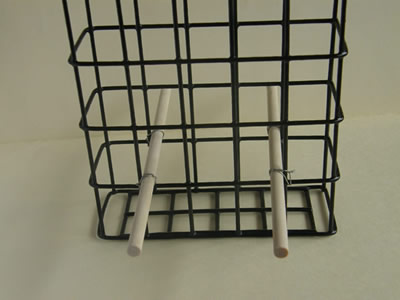 |
|
 |
Many birds are unable to cling comfortably to the suet block holders so inserting small perches is helpful. You can buy packages of short dowels at craft shops and dollar stores. Attach one or two dowels to the cage. You can vary the levels if you want. Small pieces of wire or string are used to hold the dowel perches in place. Be sure the dowels protrude on both sides. |
| | |
 |
To make our project hang, attach two pieces of wire, one for each end, through the corners of the suet cage. |
|
| | |
 |
|
 |
To keep the materials that we're going to stuff into the cage dry, use a piece of bark or other wood to make a top or roof. Carefully mark where two holes should go for the wire hangers. These should be just on the outside of the cage as shown on the right. Drill 1/4 inch holes through the top. |
| | |
 |
Feed the wires that are attached to the cage's corners through the holes in the roof. Having the wires secured like this it will be easy to open and add more materials. |
|
| |
|
|
 |
When hung up the cage gets pulled up tight to the roof. Now we just need to add some possible nesting materials. |
|
| |
|
|
 |
Stuff the feeder with things like short (4-inch) ends of string and twine, hair, wool, catkins fluff, seed heads, laundry lint, cotton batting and even mosses and lichens. |
| | |
 |
Now just sit back and watch your visitors take advantage of your creation.
This Pine Siskin really found this to be treasure trove of handy stuff for its nest! |
|
| |
|
|
|










